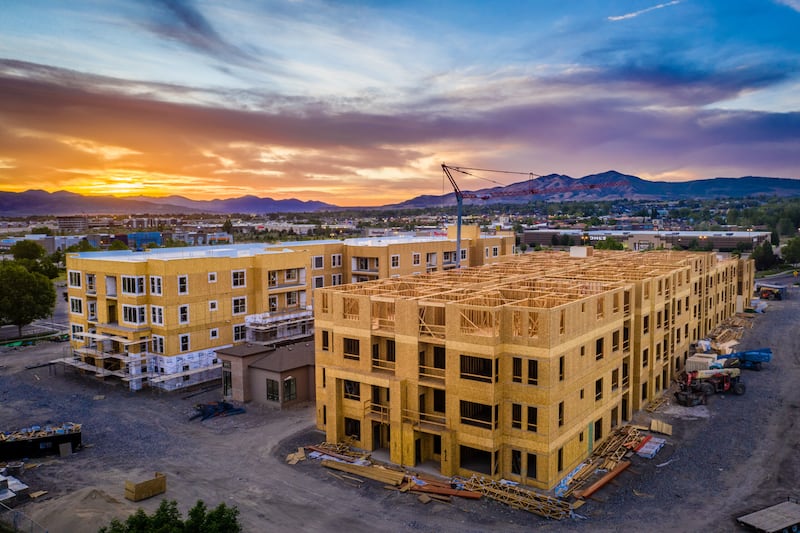This story appears in the 2024 Advisor, a publication sponsored by Colliers Utah.
There’s no escaping the eternal economic principle of supply and demand, especially when it comes to property values. Two things the most expensive cities in the world have in common are that people really want to live there (high demand) and that their capacity to accommodate expansion is constrained by strict geographic barriers—usually water or mountains (limited supply).
High-demand cities will always see housing prices increase over time, but housing prices in high-demand cities with limiting geographies follow much steeper growth trajectories. Manhattan, Seattle, Tokyo, Singapore and the San Francisco Bay Area are prime examples, and the Metro Salt Lake area—experiencing surging demand while wedged between immovable mountains and lakes—has recently become a junior member of that club.
“I never imagined Utah would be where we are right now,” says Brandon Goodman, EVP of investment sales at Colliers Utah. “During COVID-19, young professionals working remotely in primary markets realized they could move here and not only afford a home, but also have incredible access to the kinds of recreation and lifestyle options the group finds so attractive. This produced demand nobody in 2019 could have anticipated, and we weren’t ready. If we keep doing what we’re doing, that demand will never find a pressure relief valve because we’re not a market that can just continue to build horizontally.”
Dejan Eskic, senior research fellow at the Kem C. Gardner Policy Institute, is slightly less measured in describing the status quo.
“Utah has utterly failed to meet housing demand, and we got kicked in the face because of it,” he says.

To get a handle on the scope of that failure and resulting face kick, consider that, according to the most recent research by IBISWorld, Utah ranks first in the nation for economic growth and second for population growth but 36th for growth in residential construction. That stark disparity predicts the inevitability of the Federal Reserve’s reported 40 percent jump in Utah’s Home Price Index since 2019.
That Utah was caught so flat-footed seems more understandable when considering the unique nature of new housing construction. Many industries can quickly respond to unforeseen market changes by adjusting production accordingly—but the housing industry is famously not one of them.
“Any new units entering the market today were originally conceived of as a response to the market as it was five to seven years ago,” Goodman says. “Pre-2020—when the seeds of much of today’s new inventory were planted—was a different world.”
The problem is dire enough that the Utah Legislature recently commissioned a study to get a handle on it, and the outcome of that process leads with the warning: “Time is running short to accelerate action on housing policy.”
According to the study, to meet projected demand, Utah must add at least 27,900 new housing units per year for the next 16 years. The only way that’s possible is by increased reliance on high-density, multifamily housing, despite the fact that “cities that prefer single-family homes or low-density zoning can use their authority to stifle multifamily or high-density residential projects.”
Goodman says this last observation is critical to understanding the lag in getting new units to market.
“It’s not because it takes that long to find financing, buy land and do the actual construction. It’s because of the challenge of securing high-density permitting. That process currently adds years to the process,” Goodman says, blaming two related factors. “First, the places where there’s room to build were originally incorporated as small towns, never expecting they’d become suburbs. Organizationally, they weren’t set up to handle high-density. Second, the city council members who vote on these permits want to get re-elected next year and want to stay on good terms with their neighbors today. They feel a lot of pressure to keep things the way they are.”
Recognizing this, the legislature’s study suggests that a “state-level housing strategy—along with proper incentives and penalties—could better organize decentralized local government decisions toward meaningful targets for housing production. It could also provide important political cover for local leaders who can face intense pressure from constituents who do not want smaller, more affordable housing in their cities.”
Goodman says such a strategy will likely include a mechanism for developers to get up-zoning permit approvals at the state level when their projects have been subject to excessive delay at the municipal level despite being fully compliant.
“The only way we’ll ever catch up is this kind of fundamental change to the way multifamily gets approved,” Goodman says.
As for what this means for commercial developers looking to help Utah better meet multifamily housing demand, Goodman says just as politics is part of the problem at the local level, it will likely prove the solution at the state level.
“The legislature knows that in failing to increase housing supply, there’s more at stake than just higher cost of living. Most of this growth comes from job-related in-migration, and for companies to recruit and grow and keep our economy advancing, we must be able to house these workers affordably,” Goodman says. “Legislators want to get re-elected too, and when it’s understood that our title of the strongest economy in the nation may be at risk, stuff will get done.”
Goodman says he enjoys telling his clients what he thinks the near future will bring.
“I’m telling them to buy as much multifamily land as they can in the next couple of years because the coming changes are going to be so significant,” Goodman says. “Then I tell them to buy smaller parcels of land, assuming they’ll be able to go more vertical than before. We’re going to be able to get densities approved that we never have before, and that gets them especially excited.”

